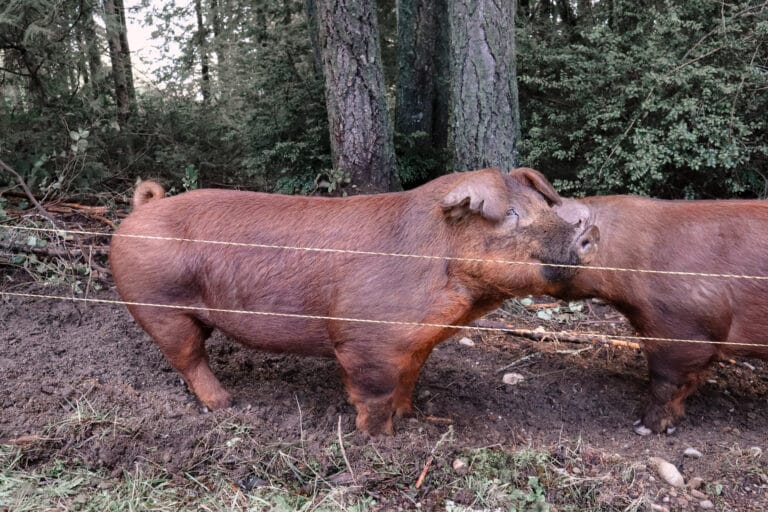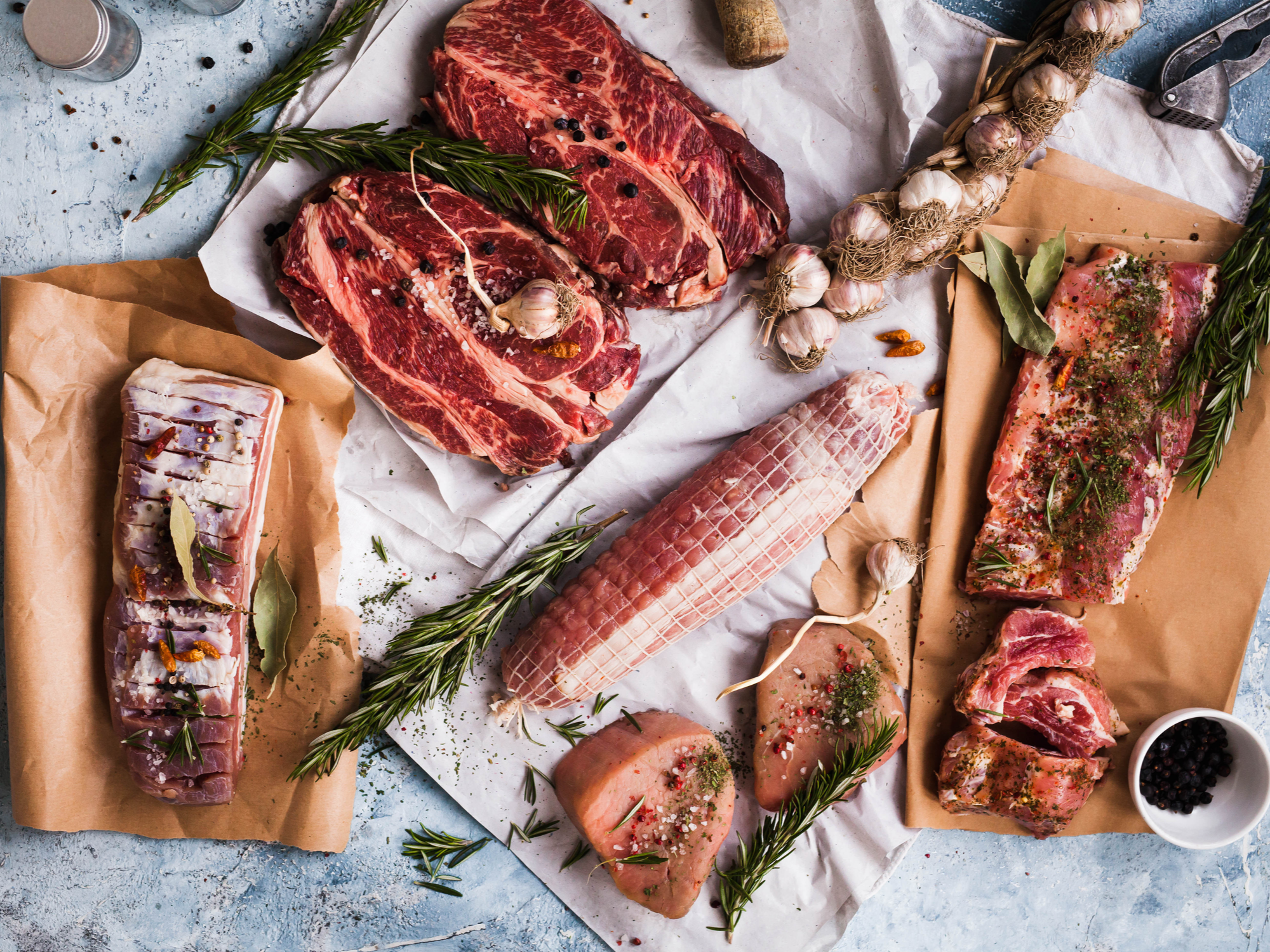

Putting pigs out into a pasture or the woods somewhere can seem very intimidating. We were also intimidated when we first did it. I really thought this was either going to be an epic disaster or the best thing we’ve ever done. Guess what?! It was absolutely the best thing we’ve ever done.
We are going to answer all those questions and more below.
Piglets when young need secure fencing. They are easily spooked and can run very fast. So if you are bringing them home from somewhere that has not yet trained them to the electric fence, you need to make sure you have a “starter pen.”
My recommendations for a starter pen are:
Training pigs? This is not often discussed in homestead groups, but it’s so important. Pigs are very smart animals and actually very easily trained. The starter pen needs to have a live electric fence in it to begin the training process. The size of your pen and resources can determine how much wire you put up.
In our “starter pen,” we put a piece of wire across one corner. Attached to the wire should be a spring, this prevents the pigs from learning how to just break the fence. Again pigs are smart, but they are also stubborn and very strong. Their thick skin will not feel the electric fence in most cases, the biggest point of deterrent will be the nose. Therefore, all electric wires should be at nose height, which will be determined by the age and breed of your pig.
The spring is probably the most important tip here. The spring will allow the pig to push or even run through the fence (that is why you have a solid fence barrier behind it) without breaking the wire. The purpose to teach them to not run through the fence.
One other training tip is to teach them manners. Pigs can easily get aggressive especially around feeding time. Use a pig stick to teach them to back off away from you. This can also be useful when it’s time to move them and for trailering to slaughter.
Once your piglets are trained they are ready for the pasture or woods. The good news is since you properly trained them a fence is simple. You only need:
That’s it! It’s so simple and you’re pigs will be rooting around happily in no time!
The best water source we have come up with is a 55-gallon food-grade drum with a pig nipple. It needs to be monitored regularly because as soon as it’s empty enough they will knock it over. We also use a ratchet strap to secure it to a tree if possible. A small pallet can also be useful for keeping it level on uneven ground. Also, keep in mind how you will fill it. We use a series of many hoses to get to our drums, but since we are on an old stables’ property we have several water sources throughout the property.
Pigs on pasture or in the woods will find lots of great things to root up and eat, but that will not be enough to grow them out productively for butchering. A large breed hog needs a certain amount of protein and nutrients to properly develop its massive body. What you feed and how much will depend greatly on the breed of the pig and how fast you want them to grow.
Pigs need some form of shelter to get away from heat, rain, wind, or too much sun. They are very hardy animals and can find shelter themselves in many places, and may not need a shelter provided by you. This will really depend on where you have them located on your property.
Our pigs are kept in heavily wooded areas, so our biggest concern is moisture. While small rain showers will not get them wet, the constant rainfall in the fall soaks everything in the woods. We provide a small hoop house and make sure the ground underneath it stays dry.
Every single day walk the perimeter of your electric fence. Once again pigs are smart, all it takes is one small branch down on a line and they will be out of your fence. So each day while feeding, check the fence, the charger, and the brush and trees surrounding the fence.
Moving pigs can seem like an intimidating process, but with careful planning, it can be done quickly and efficiently. Joel Salatin suggests using a solid wooden gate between rotating pens. This is really a genius concept. Pigs actually have very bad eyesight, so they learn where the fence is, and then we ask them to walk across it; they think we are mad. So a solid wooden gate that is now removed is less intimidating to them and they can easily learn to walk through the opening.
Before you even get your pigs, plan your pasture rotation. Large breed hogs will take approximately 6 months to grow out, so calculate ahead to figure out what seasons you will have them in. Pens need to be attached consecutively, so plan how you will achieve that. In cases where you need to make a big jump or move sometimes you can create a tunnel, but that will be more complicated so try to avoid that scenario as much as possible.
Knowing your land will help make this process much more successful. Again evaluate the season, if it’s wet season figure where wet spots will be, and keep your water source, shelter, and food out of those areas. If it’s dry and hot season make sure they have as much natural shelter as possible and prepare ways to help them get cool, like making mud wallows. Don’t overthink this process because it will never be perfect, but preparing can help make it easier.
There is a reason farmers like growing pigs in small containments, putting any animal out in a pasture is harder to evaluate regularly. Homesteaders have a great advantage of being smaller operations and have the ability to carefully watch their animals. Take the time to get to know your pigs so that you will know when something is wrong. Check their skin, eyes, ears, and feet regularly after dumping feed. It’s the best time because they are finally “mostly” still. Watch them for lameness, especially in the wet winter months. Also, keep an eye on their behavior with each other, if you have one that is eating more and pushing the others away, you may need to dump feed in multiple areas and play a little trickery on the dominant one.
Raising pastured pigs while working full time and being an aspiring homesteader can seem overwhelming, but it is worth it. The best part of pastured or forested pigs is they provide the best meat. Proper rotation and nutrition give them a nice balance of leanness and marbling. We raised our pigs in a pen for the first two years and we constantly struggled with mud management, pigs gaining unevenly, overeating, and lower meat quality. Pastured pigs were the best thing we ever did. They are so much happier, healthier, and have a better meat quality. Don’t overthink it, start planning your pastured pigs today!




No spam, notifications only about current blog updates.
3 Responses
This was very helpful. I liked #4 and 5.
Thank you very much.